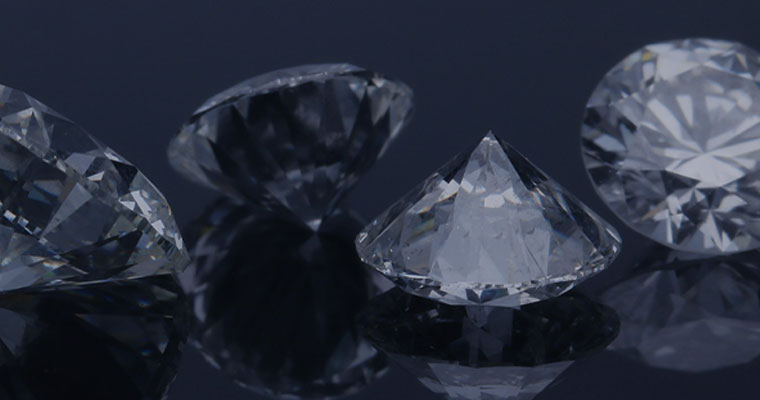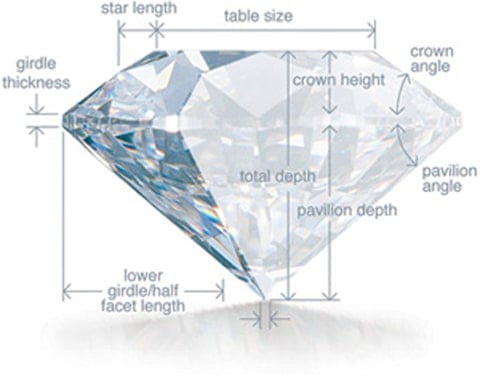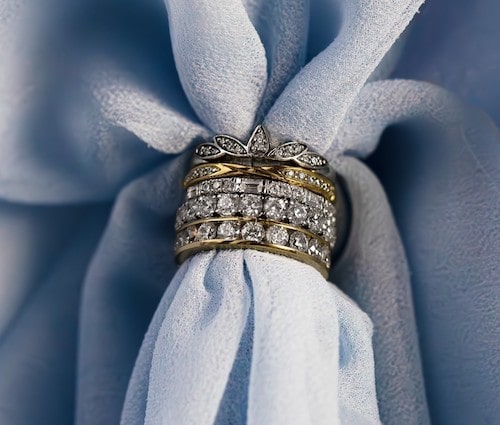

Diamond Buying Guide
Diamond Buying Guide
Buying a diamond is a big decision. After all, diamonds are forever. So, what should you consider when choosing a diamond? Our diamond buying guide outlines everything you need to know before making that all-important investment. From formation to purchase, our diamond buying guide covers it all. We explore all things carat, clarity, colour and cut, so you can confidently buy the diamond of your dreams.
About Diamonds
Derived from the Greek word 'adámas' meaning "unbreakable", diamonds were discovered and mined in India between 3000 and 6000 BC. Since then, diamonds have become the ultimate symbol of unbreakable love, famously chosen for engagement rings.
Diamonds are also the hardest known natural mineral on Earth. So, they aren’t only desired for their beauty and ability to disperse lights into a stunning spectrum of colour – they’re also inherently valuable due to their natural properties. These qualities - hardness, rarity and purity – all contribute to their value, positioning them as one of the most expensive precious stones on the market.
How are diamonds formed?
Natural diamonds are formed when carbon deposits are exposed to extreme pressure and heat. Formed at a depth of around 87 to 120 miles, volcanic eruptions provide the necessary momentum to encourage diamonds closer to the Earth's surface, where they can then be mined.
However, this is not the only way diamonds can be formed. In 1954, the technology was developed to create synthetic or lab grown diamonds. Lab grown diamonds are exposed to the same conditions as natural diamonds and share the same chemical and physical properties as natural diamonds. The only difference is they are formed within a controlled environment.
How are diamonds graded?
Diamonds are assessed and graded according to the 4C’s – carat, clarity, colour and cut. The combination of the 4C’s determine the overall quality of a diamond. Each category focuses on a different feature and uses a unique scale to create a report that determines the quality and cost of the diamond. But what are the 4C’s?
Carat
Carat refers to the weight of a diamond. To learn more about diamond carats and how to choose the right carat for your piece of diamond jewellery, visit the ‘Carat’ tab above.
Clarity
Diamond clarity refers to the amount of imperfections found on or within a diamond. To learn more about diamond clarity and how it impacts price, visit the ‘Clarity’ tab above.
Colour
Diamond colour refers to the lack of colour in a diamond. To learn more about the diamond colour scale, visit the ‘Colour’ tab above.
Cut
Contrary to popular belief, diamond cut refers to the symmetry and polish of a diamond. To learn more about the diamond cut grades, visit the ‘Colour’ tab above.
What elements make up the anatomy of a diamond?
There are five main elements that contribute to the anatomy of a diamond - these include the:
- Table – the table refers to the flat diamond facet on the very top of the diamond – it is also the largest diamond facet.
- Crown – the crown is the upper portion of the diamond that extends from the table to the girdle.
- Girdle – the girdle connects the crown and the pavilion portion of the diamond, creating the widest edge.
- Pavilion – the pavilion refers to the bottom half the of the diamond, extending from the girdle to the cutlet.
- Cutlet – the cutlet describes the pointed facet at the bottom of the diamond.

Buying Diamond Jewellery
Buying a piece of diamond jewellery requires careful consideration. After all, it is a life long investment. But where should you begin? Our team at Shining Diamonds have created a step-by-step guide to help you purchase the perfect piece of diamond jewellery.
Set your budget
Before purchasing a piece diamond jewellery, whether it’s an engagement ring or a pair of earrings – you must first set your budget. A clearly defined budget allows you to filter your search, so you can select the highest quality diamond within your price range.
How much should you spend on an engagement ring?
How much you spend on a piece of diamond jewellery is entirely up to you. However, when it comes to engagement rings, we usually recommend setting aside approximately 3 month’s salary. Whilst this will vary from person to person, three months savings will ensure that no matter your budget - you have sufficient funds to find your partner the perfect diamond engagement ring.
Find a reputable jewellers
Finding a reputable jeweller is essential to the diamond buying process. After all, you want to ensure you’re receiving the highest quality diamonds for your money. So, how do you find a reputable jewellers?
Read the reviews
One of the most efficient ways to find a reputable jewellers is to read online reviews. Customer testimonials offer an honest insight into the quality of the service and the products available, with no hidden agenda.
Read our Trustpilot reviews to see what our customers say about our independent diamond jewellers.
Assess their accreditation
We strongly suggest that you only buy from jewellers who are members of the National Association of Jewellers (NAJ). Accreditation from a professional body like NAJ provides quality assurance for customers by regularly performing quality audits and authenticity checks. If you’re buying online, look out for the Assay Assured logo to verify their credibility.
Contact the retailer
If you have any questions, you should contact the jeweller directly. Visiting the store or speaking to an expert online will give you an insight into the quality of customer service you expect to receive.
At Shining Diamonds, our diamond experts are always happy to help. Simply contact us online or book an appointment at our Hatton Garden or Brighton store.
Consider the different types of diamonds
Before exploring different diamond shapes and styles, you should consider the type of diamond you want to buy. Whilst natural diamonds are an historically popular choice, lab grown diamonds offer an ethically sourced and affordable alternative. With the same chemical and physical properties as natural diamonds, they are identical counterparts – the only difference is how they are formed.
Why buy a lab grown diamond?
There are many reasons why you should considering buying a lab grown diamond – some of which include:
- Sustainability – Diamond mining can be incredibly damaging to the environment. By opting for a lab grown diamond, you’re able to eliminate the need for mining, whilst also reducing carbon emissions by sourcing your diamond locally.
- Cost-efficiency – Due to their rarity, natural diamonds are priced significantly higher than lab grown diamonds. However, since resale prices for both natural and lab grown diamonds is around 40% less than the original retail price, lab grown diamonds are widely considered a more cost-effective alternative.
- Identical features – With identical chemical, physical and optical properties, lab grown diamonds are 100% genuine diamonds – they simply offer customers an alternative to mined diamonds.
Select your shape
Whether you’re buying an engagement ring, a diamond pendant or a pair of earrings, the shape of your diamond will significantly impact the style and appearance of your jewellery. So how do you choose a diamond shape?
Firstly, you need to consider the wearers preferences. Do they prefer modern or traditional designs? For those who love a timeless classic - round, marquise and cushion shaped diamonds are historically popular choices. Alternatively, oval, emerald and princess cut diamonds are modern favourites across our Instagram feeds, breathing new life into shapes we’ve enjoyed for years.
Secondly, you should consider what size diamond would suit their lifestyle. For example, if they lead a very active lifestyle, a large diamond may be impractical. But how does the shape of a diamond impact the size? Whilst they aren’t directly linked, some diamond shapes appear larger than others. Take a marquise diamond for example. Placed alongside an oval diamond of the same carat size, it would still appear larger due to its tapered points creating a larger surface area.
Consider the style
Diamond jewellery should reflect the style of the wearer. So it’s important to identify their style preferences.
For those who prefer minimal designs, solitaire rings, pendants and stud earrings all feature a singular, stunning diamond. However, halo and cluster designs offer an eye-catching alternative for those who love a lot of sparkle. Style preferences vary from person to person, so if you’re buying on behalf of a loved one, we suggest looking at their existing jewellery collection and speaking to a close friend or family member.
Assess the 4C’s
The remainder of our Diamond Buying Guide deep dives into each of the 4C’s. So, for this section of the guide, we’re going discuss which of the 4C’s to prioritise when buying diamonds.
Whilst all 4C’s determine the overall quality of your diamond, the cut of the diamond is widely considered the most important of all 4C’s. Why? Because the cut determines the brilliance (or the sparkle) of the diamond. Without a good quality cut, your diamond will appear dull, regardless of clarity or colour.
Next, you should consider colour and clarity. The same rule applies for both of these categories –you should base your decision on what is visible to the naked eye. Whilst you can purchase flawless, colourless diamonds, the price is significantly higher than lower grade diamonds. Therefore, we suggest opting for a diamond that looks flawless and colourless – even if it’s not perfectly graded.
Finally, the diamond carat. Often mistaken for the size of the diamond, the carat actually refers to the weight of a diamond. So, if you’re searching for a ‘large’ diamond, don’t assume that you need a large carat size too. Instead, assess which shapes maximise the surface area of your diamond to make it appear larger than other diamonds of the same carat size.
Check the certificate
All reliable jewellers should provide official documentation to validate the authenticity of their diamonds. These reports should be from certified bodies like GIA or IGI, detailing the diamonds unique features and report number which is microscopically inscribed onto the girdle of the diamond.
To learn more about diamond certification, visit the ‘Certificate’ tab at the top of the page or click here.
Buying Diamond Jewellery Online
Whilst some people are apprehensive to buy diamond jewellery online, when purchased from a reliable jewellers, the process of buying diamond jewellery online is actually incredibly efficient. Read on to learn how to buy a piece of diamond jewellery from Shining Diamonds.
Select your piece of diamond jewellery
Begin by exploring our extensive range of diamond jewellery. From engagement and wedding rings to diamond earrings and pendants, our diamond jewellery collection is categorised for your convenience. Once you have selected your category, you can filter your search by shape, style and metal until you find your perfect piece.
Customise your design
Once you have selected your piece of diamond jewellery, you’ll be able to customise your design. It’s worth noting, some pieces are highly customisable, whilst others have fewer customisable features. However, for the purpose of this guide, we’ll outline a comprehensive list of features you can customise when creating a bespoke piece of diamond jewellery.
- Metal – from platinum to rose gold, you can choose your metal based on the wearers preference/existing jewellery collection.
- Ring Size – if you’re buying a diamond ring, you’ll need to select the wearers ring size.
- Diamond Type – our diamond rings can be created with natural white, lab grown white or natural coloured diamonds.
- 4C’s – with sliding scales for each of the 4C’s, you can select the exact grade of diamond carat, cut, clarity and colour for your chosen piece of diamond jewellery.
- Certificate – select a professional body to verify your diamond and provide a report to accompany your purchase.
- Advanced Filters – for some of our pieces, we also provide sliding scales for the polish, symmetry and fluorescence of your diamond.
As you customise your design, the price of your design will automatically update. However, if you’re customising your diamond grade, don’t forget to add your chosen diamond from the table beneath the sliding scales before adding to your basket.
Purchase your perfect diamond
Once you’ve added your piece of diamond jewellery to your basket, all that’s left to do is to proceed to checkout. There you will be presented with payment methods, including ‘Finance’, if you’re looking to pay in instalments. To learn more about our finance options, visit our finance page.
Want to learn more about diamond quality? Using the tabs at the top of the page, you can read all about diamond carat, cut, colour and clarity. Our diamond buying guide has you covered for all your diamond ring requirements and queries. Alternatively, get in touch with a member of our team for more information about what to look for in a diamond.



